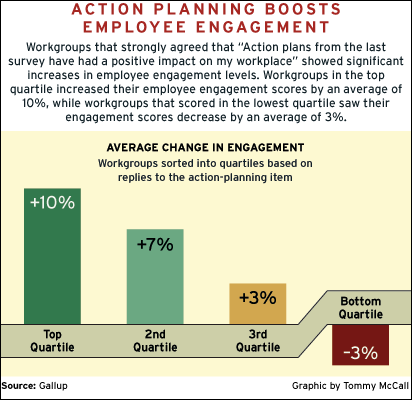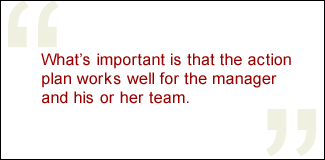Employee engagement surveys can do a lot of good. When employees and managers discuss the results, these conversations can lead to increased engagement, productivity, and profits while reducing turnover and costs.
But discussions of survey results often get moved to the back burner. Why? Rather than seeing these conversations as a tool for improving performance, managers sometimes view them as one more item on their "to do" list. That's a serious mistake, because neglecting survey results is a proven way to undermine engagement. Employees doubt the motives of managers who ask for their opinions, then don't do anything with them.
Employees expect and need resolution, and one of the best ways to do this is through action planning (this process is also called "impact planning"). Though the methods vary, action planning is essentially a process in which a manager discusses survey results with his or her workgroup. Then the group collectively selects specific issues to work on and improve. This process is inherently more valuable than many managers realize, according to Gallup research. In fact, it's one of the key drivers of improved employee engagement.
The importance of action planning
Gallup has been researching employee engagement for more than 30 years. To measure engagement, Gallup uses a 12-item survey, the Q12; its items link to important business outcomes, including increased retention, productivity, profitability, and customer engagement, and improvements in safety, absenteeism, and shrinkage. (See the graphic "The 12 Elements of Great Managing" at the end of this article.)
To determine the effect of action planning on engagement, we looked at workgroups with Q12 data that could be trended across two consecutive survey administrations. We considered answers to an additional survey item, "Action plans from the last survey have had a positive impact on my workplace," a question that is often asked of workgroups in the second or subsequent survey administrations. We then sorted workgroups into quartiles based on their replies to the action-planning item. We discovered that workgroups in the top quartile increased their employee engagement scores by an average of 10%. In contrast, workgroups in the lowest quartile on the action-planning item saw their engagement scores decrease by an average of 3%. So the groups that strongly agreed that their action plans had a positive impact showed significant increases in employee engagement levels. Workgroups whose workplace improves year over year as a result of action planning become even more engaged in subsequent years.
 |
Setting goals
So action planning has a direct and measurable impact on employee engagement. Now what? What does a great action plan look like? Well, there isn't a "one-size-fits-all" model. What's important is that the action plan works well for the manager and his or her team. Because managers and employees bring their own talents and strengths to the workplace, each action-planning session is unique, and that's just the way it should be. The process needs to be positive and should involve everyone on the team.
Through our research, Gallup has discovered that these six steps are crucial to making action planning an effective part of an employee engagement improvement process:
 |
- Introduce the action-planning session and state its purpose. This will help employees understand what engagement is, why the survey was conducted and what it measures, what the survey items mean to them and to their workgroup, and why action planning is a vital step in improving employee engagement.
- Distribute and explain the survey results.
- Discuss what those results mean for the workgroup, item by item.
- Select two or three key items to work on over the next 12 months.
- Brainstorm follow-up actions and complete a plan for improvement.
- Follow up regularly on the plan, and on how people are feeling about the team's progress toward meeting its goals.
Before sharing results with their teams, managers should explain to team members the concept of employee engagement and how the survey is used to measure engagement. Managers should then facilitate an open discussion about the survey results, item by item, encouraging input from all team members. Finally, managers and their teams should decide which items the team should work on, decide what actions need to be taken to improve engagement, assign "owners" to each task, and set timelines and dates for follow up.
All of this effort is aimed at establishing goals -- and goals are important because they motivate employees to focus their efforts and improve their performance. According to research findings, a number of mechanisms need to be in place for goals to make a difference. Managers must be able to communicate the reasons for action planning clearly so employees can understand what action planning is and why it's important for the team. Workgroup members need to agree on the team's goals, then commit, publicly and explicitly, to working toward them. They also need regular feedback about their progress. Managers should encourage the team to make discussions of the team's issues -- and the team's goals for overcoming them -- simple and honest.
More and less
But how does all this work in the real world? To find out, we studied managers in Australia with high employee engagement scores as measured by the Q12. We uncovered a variety of ways these managers responded to their workgroups' feedback, all of which produced superior results in subsequent surveys.
- Formal. Some managers followed a formal action-planning process. Within a week of receiving their results, they got their groups together to discuss the results. The managers presented the results, then asked open-ended questions about each of the items in the survey. They asked things like, "What would it take for you to strongly agree with this item?" These managers listened, made notes, and involved everyone in the group discussion.
In these instances, the manager acted as facilitator while the team discussed which survey items were priorities for improvement. (It's also appropriate for a team member to facilitate this discussion.) We found that these teams continued the action-planning process throughout the year; when one project finished, another was chosen. On the next survey, the team members were able to "strongly agree" with the statement, "Action plans from the last survey have had a positive impact on my workplace," and these teams saw overall improvement in employee engagement scores.
- Informal. But action planning does not need to be formal to be effective. One branch manager at a retail bank simply embedded improving each survey item into her employees' daily working lives. For example, when the branch's break room water heater broke down, the branch manager called the team together to discuss options. When they heard that a replacement wall unit would cost $1,000 AUD ($769 USD), they suggested simply buying an electric kettle ($50 AUD; $38 USD) to see if that would be sufficient for the needs of the group. It was, and the team had more reason to feel they had the "materials and equipment" to do their jobs right.
This informal approach was based on input from the team -- when they got together to discuss their survey results, they decided that they preferred no formal action planning around specific items, because their scores were consistently high. Instead, they chose to actively think about ways to improve their workplace as part of their daily routines at work. The branch manager meets with the group as a whole and with each team member individually at least once a week to discuss goals, obstacles, and improvement ideas. She makes it clear that she cares about each person in the group and that she values their opinions and observations.
Though very different, these examples of action planning have a basic similarity: Employees and managers left their action-planning sessions knowing what needed to be accomplished and having a clear idea of purpose. Providing employees with an outline of the steps involved in action planning will help establish expectations and anticipated outcomes. Engaging employees in the action-planning process requires managers to help employees understand what is expected of them at work.
What not to do
Action planning boosts employee engagement partly because the process itself demonstrates that the opinions of each person on the team count. So it's important to establish ground rules of mutual respect and open dialogue for the process to work effectively. If a manager systematically dismisses suggestions or discounts individual contributions, employees are likely to give low ratings to items such as "At work, my opinions seem to count" or "My supervisor, or someone at work, seems to care about me as a person." That's also why action planning doesn't work when managers nominate action items and suggest that employees "fix" them. To be effective, the process of determining priorities must be fair and equitable, and it must originate with the team.
We know this because we've researched it. And that research has turned up some classic examples of what not to do. One manager thought low scores on the item "I have the materials and equipment I need to do my work right" were linked to a delay in installation of a new computer system. In reality, a shortage of space and desks meant there was no permanent place for staff members to sit. Every time they returned to their work station from a bathroom break, employees had to negotiate with someone to get their desk back. Making assumptions about what is important to staff members can lead to efforts that fail to improve engagement. The better approach is to simply ask them during the action-planning process, "What does 'materials and equipment' mean to you?"
 |
Another manager made staff members stay after work hours to action plan as a punishment for rating the workplace poorly. It's difficult for employees to link the importance of action planning to business success when their manager will make time for it only outside of normal business hours. And you can guess how they rated items relating to management support.
Plan ahead
It's hard to exaggerate the benefits of action planning when it's done well. And it's equally hard to predict the many ways poor action planning undermines the team. In the end, managers who care about employee engagement need to care just as much about doing something with the feedback they get. The payoff for action planning will be improved employee engagement -- and measurable performance increases.
 |


